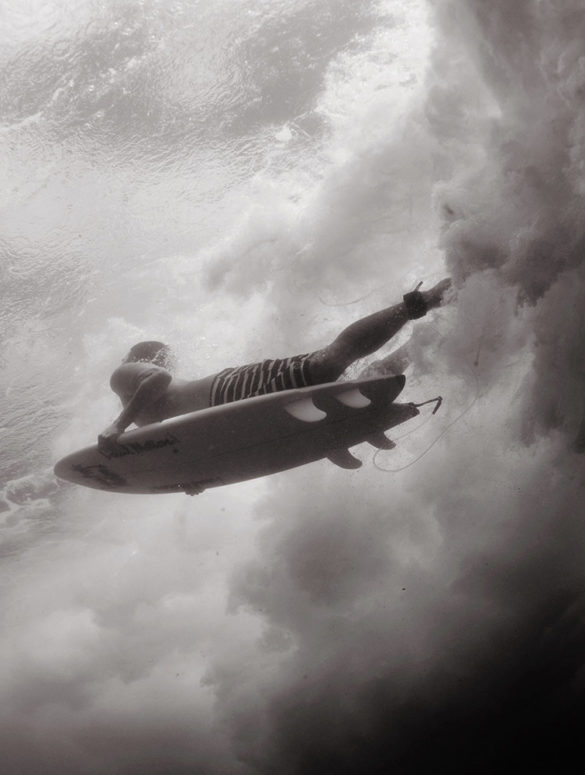Listen as surfers stride up to Waikīkī Beach after a session and you might hear them tell of a crowded lineup at Pops, a nose ride at Paradise, or the glassy waves firing at Threes. These breaks, where surfers diverge to exploit differences in wave direction and shape, often contain wide-ranging histories and deep cultural resonances with local communities past and present.
Waikīkī’s two most famous and accessible breaks are referred to as Queens—named so because it was fronted by the beach house of Hawai‘i’s last monarch, Queen Lili‘uokalani—and Canoes, a nod to the vessels that navigated its waves when the Outrigger Canoe Club began as a grass hut on the adjoining stretch of beach. When conditions at these breaks wavered, the club’s mid-century surfers paddled further west, first hitting Populars (or “Pops,” as it’s commonly known) and then Paradise, aptly named for its ideal waves. The third and fourth breaks in that coastal trajectory simply became known as Threes and Fours.
Duke Kahanamoku made history in the 1930s when he surfed nearly all of Waikīkī’s breaks in one continuous ride. Taking off from a legendary outside break known as Kalehuawehe, “The Duke,” as he was called, used the momentum of his 16-foot board to thread the many channels to Canoes. “According to legend,” write the authors of Surfing: A History of the Ancient Hawaiian Sport, “the name Ka-lehua-wehe (meaning ‘the removed lehua’) was inspired by a surfer who, while riding at this break, removed his lei made from lehua blossoms and presented it to a chiefess who was also riding there.” Hawaiian scholars also list Kalehuawehe as a site where the sick were brought for cleansing.
This heritage was eclipsed when the break was later dubbed Castles, named after the missionary-turned-sugar baron Samuel Castle’s three-story estate, which stood at the current site of the Elks Club Lodge from 1920 to 1958. When big swells break at Kalehuawehe, their ripples eventually dribble onto what became known as Kawehewehe Beach—named, as with Kalehuawehe, in reference to the removal of lei and rituals of healing. Today, the swimming area is more commonly known as Gray’s Beach, for a short-lived boardinghouse called Grays-by-the-Sea.
In their book, Waikīkī: A History of Forgetting and Remembering, authors Andrea Feeser and Gaye Chan reanimate the rituals involving seaweed lei at Kawehewehe, where a purifying freshwater stream once flowed into the sea. “Penitents ducked under the water to free the lei,” they write, “and then walked to shore without looking back, in a gesture that symbolized the release of illness.” Of course, natural remedies were futile in the face of Western contagion, and when native populations plummeted, so too did the use of Hawaiian language. Eventually, deep-rooted names of sacred spaces, like those where oceanic healing and recreation overlapped, lost ground to English substitutes.
There are few constants in the fluid history of Waikīkī surfing. The tides are always changing. But year after year, sure as each summer swell, the outstretched arms of The Duke’s lei-strewn statue at Kuhio Beach continue to greet the steady flow of surfers. And while many learn to float across the water, most barely scratch the surface.





